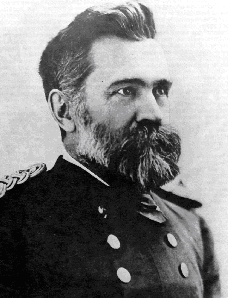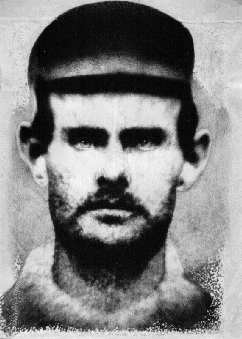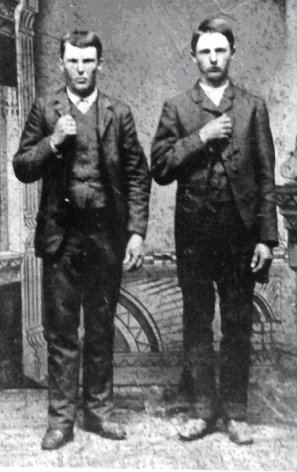|

|
|
Col. William R. King, district engineer
who built Muscle Shoals Canal
|
Major William R. King, in charge of improvements on the Tennessee and Cumberland rivers, filed an unusual report with the Chief of Engineers in 1881. Amidst the usual extensive remarks on navigation improvements on the two rivers he added this comment: “It becomes my duty at this point to record the circumstances of a robbery of public funds that occurred on the line of the canal between Shoal Creek and Blue Water Camps, on the 11th of March last.”
It seems that about 4 p.m. that rainy, windy Friday, Mr. Alexander G. Smith, the “receiver of materials” (paymaster) at the Blue Water Camp, Muscle Shoals Canal, was overtaken by three armed men as he attempted to deliver the payroll from Florence 15 miles back to camp. The three robbers took the funds at gunpoint and, with Smith held prisoner, rode furiously about 20 miles into desolate barrens. After splitting the loot (and allowing Smith to keep his own money and gold watch), they released him that night, unharmed, during a torrential rainstorm, to find his way back to camp. The stolen funds totaled $5,240.18 -- $500 in gold, $4,500 in $50 bills, a stack of smaller bills, and some change.
Smith arrived back at camp at daybreak where the Engineers mounted up riding hard to intercept the bandits. Unfortunately, their efforts were in vain. Although the Engineer posse pursued the thieves nearly to the Cumberland River, rain finally obliterated the tracks. The first break in the case occurred when William ('Whiskey Head') Ryan turned up at White’s Creek Store and Saloon near Nashville seeking shelter from a heavy rain. After consuming raw oysters and raw whiskey, he became drunk and disorderly, was arrested by Nashville police, and subsequently identified as one of the robbers. The authorities took "some $1,400 in gold and currency" from Ryan, which they turned over to Major King. King learned that the other two bandits probably were in Kentucky. Unfortunately, the Marshal refused to try to apprehend them without a detachment of soldiers to help make the arrest, local authorities refused to give chase, and King could not receive authority to post a reward.
 |
Jesse James at 33, Nashville, Tenn.,
the year before the Corps' payroll heist |
King commented, "There is no doubt of the identify of this gang with the celebrated James band of outlaws-- the man, Ryan, having in fact been fully identified as one of them, at Kansas City, where he has been taken for trial on a requisition from the Governor of Missouri for certain robberies in that State." King was quite correct. The unfortunate Mr. Smith had been held up by one of the most infamous gangs of robbers in American history. Besides Ryan, the gang consisted of Jesse and his brother Frank (Alexander Franklin) James. Frank hid out with his family in Virginia. Jesse left for Kansas City and then on to St. Joseph, where he lived under the name of Thomas Howard.
King optimistically anticipated the eventual capture of Jesse James and his gang because of the substantial rewards posted by the Missouri governor for robberies in that state. But fate intervened. In the spring, 1882, another gang member, Robert Ford, treacherously shot James in the back of the head in St. Joseph. Jesse died instantly.
Frank surrendered six months later. In April 1884, he stood trial in Huntsville, Alabama, for the payroll robbery. Represented by a team of outstanding lawyers, Frank was acquitted, although seven witnesses identified him as being one of the three robbers. Frank went on to live a 'respectable life' until his death in 1915. Whiskey Head Ryan, sentenced to 25 years for a train robbery in Missouri, was released in 1889 only to hit a tree branch at full gallop fracturing his skull.
Presumably, workers at the Corps' Blue Water Camp eventually got their paychecks.
 |
| Jesse (25) and Frank James (29), 1872, Carolinda, Ill. |
Sources:
Engineers on the Twin Rivers, A History of the Nashville District, Leland R. Johnson, 1978.
Annual Report of the Chief of Engineers (1881), Part 2.
Special thanks to Mr. Phillip W. Steele and the 'James-Younger Gang' webpage for use of these historic family photographs and anecdotes.
* * *
June 2001